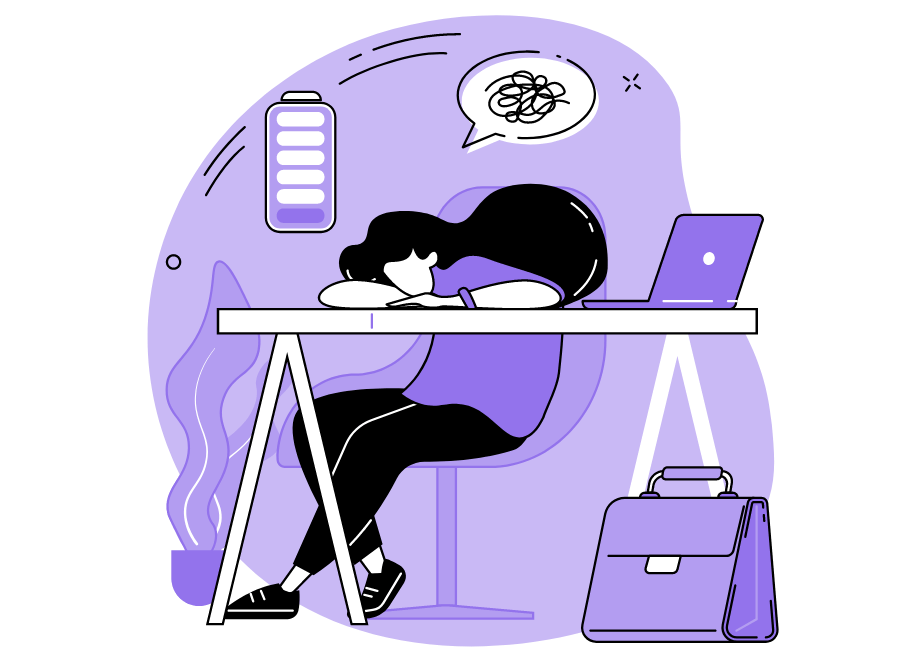
As a manager, you want to provide a great working environment to your developers—for their well-being and for the good of the company.
In a healthy atmosphere, your employees will flourish, advancing their skills and pushing the company forward.
However, in a toxic culture where everyone is overworked, you can only expect productivity to drop and production to lag.
Therefore, it’s in your—and your team’s—best interest to avoid burnout.
In this article, we’ll guide you through all the ins and outs of the condition, explaining its impact, how to spot the warning signs, and how to prevent it.
Table of Contents
What is developer burnout
Burnout is a widespread problem in the workplace.
Not to be taken lightly, this phenomenon is a severe mental health challenge many businesses struggle with—including the world of software development.
The World Health Organization defines burnout as follows:

In other words, burnout occurs when employees suffer never-ending, work-related challenges that induce anxiety.
It is destructive on several levels and can cause serious issues in the workplace. Burnout manifests itself in three distinct areas, displayed in the visual below:

Burnout symptoms are both physical and psychological, with employees often experiencing fatigue, depression, and other psychosomatic illnesses.

Get unreal data to fix real issues in your app & web.
This then leads to a steep drop in productivity, along with a feeling of detachment from one’s workload. Developers will feel less motivated and won’t perform as efficiently as before.
For all these reasons, it’s vital to understand the impact of developer burnout and how to recognize it early on.
The impact of developer burnout
A new study by Haystack Analytics revealed some concerning facts regarding the prevalence of burnout in the software industry.

This is alarming, as burnout will negatively affect a developer’s performance, killing productivity and motivation until employees cannot work at all.
If you fail to address the underlying issues, before you know it, the affected developers will become more of a hindrance than an asset to your team, and your entire team will suffer.
This is what makes burnout especially dangerous—its effects reach farther than one developer.
As soon as someone isn’t performing at full capacity, the other team members have to take on their workload along with their own. As a result, the project they’re working on suffers.
The delicate nature of the projects contributes to the high incidence of burnout in software development. Eric Shanks, a senior architect, commented on this:

The astronomical consequences of miscalculation make this phenomenon even more dangerous.
Developers get nervous and overwork themselves to ensure the best possible execution.
However, since overexertion causes those developers to become burned out in the first place, they lose concentration and energy and can easily make mistakes.
As a result, companies wind up once more with the same damage control costs the developers worked so hard to avoid. It’s a vicious cycle.
Signs of developer burnout
Burnout affects employees both psychologically and physically.
It’s not only mental health that suffers. You shouldn’t be surprised if your burned-out employees start complaining of neck pains, insomnia, and fatigue.
A recent study revealed the following troubling numbers:

Although burnout is detrimental to mental health, these alarming numbers prove that poor physical health can also be a clear indication of burnout.
As a manager, you’d do well to look out for disgruntled, anxious, or unwell developers—there’s a chance they’re suffering from burnout. Read on to learn about some of the most common signs.
Lack of energy
A burned-out developer is likely pulling long hours and working later than the others.
When employees overwork themselves, the inevitable lack of rest frequently results in a lack of energy. Your developers won’t have the physical capacity to complete their tasks.
A recent survey uncovered alarming statistics about burnout and lack of energy:

Clearly, burned-out developers are prone to listlessness. If you catch your developers staring blankly at their screen, yawning frequently, or dragging their feet after coffee, talk to them.
They might very well be burned out.
It’s essential to keep in mind, however, that burned-out employees won’t be falling asleep at their desks or completely giving up on their work.
Although your developers will be exhausted, they will still anxiously be trying to complete their tasks, however erratically.
Psychoanalyst Josh Cohen described this phenomenon:

In other words, don’t wait for your employees to fall over before intervening. Although they’ll be on their last legs, they will still push themselves to work.
They’ll just be doing so slowly, red-eyed, and with frequent breaks. Make sure you catch these signs and speak to them as soon as possible.
Decrease in productivity
Another telltale sign of burnout is a drop in productivity.
If your developer is taking longer than usual to complete tasks, or if you notice more and more bugs, don’t immediately write this off as laziness—it could also be burnout.
Software developers are most productive when the workplace conditions are supportive. However, productivity automatically plummets if they’re not in a healthy environment.
A recent research paper also highlighted this:

Without favorable conditions, your developers won’t work well. This is why it’s vital to intervene as soon as there is a drop in quality. You don’t want these bad habits to go on for too long.
Furthermore, remember that spending hours in front of a computer doesn’t automatically equal high quality. Clocking 8 hours—or longer—isn’t the same as being productive.
Bob Pozen, a productivity expert, has mentioned this:

In short, time spent at a desk isn’t the same as productivity. If you notice a dip in quality, try increasing the frequency of your code reviews.
You could catch burnout in the beginning stages, and the private nature of a code review is the perfect chance to check in with your developer.
No passion for work
Chances are, your developers started coding because they enjoyed it. They wouldn’t have pursued the occupation otherwise. After all, who wants to have a career they dislike?
However, perhaps the most regrettable sign of burnout is losing the passion for work.
If your developers aren’t celebrating a new feature release or have stopped bringing up their career goals (or even personal side projects), they’re likely burned out.
Anne Helen Petersen has written about this:

If you give your developers an exciting new project to work on (after months of dealing with databases), and they don’t react enthusiastically, check in with them.
They might be nearing burnout.
Furthermore, as developers lose their drive for employment, their relationship with the company gradually deteriorates. They are no longer invested in their company’s success.
A research paper on burnout also mentioned this:

As your developers’ passion slowly dwindles, keeping them with the company becomes increasingly difficult.
A developer who dislikes coding will eventually stop wanting to work altogether, and you will have lost a valued team member.
This can be a massive blow to your company. If you have a worthwhile employee, you want to do your best to keep them.
Five stages of burnout
Burnout does not happen overnight. It’s a slow, gradual process that develops over time.
One bad day in the office doesn’t automatically result in burnout—developers must be exposed to unfavorable working conditions for a prolonged period for burnout to set in fully.
There are five stages of burnout, depicted in the visual below:

As a manager, it’s crucial to catch the signs of burnout early on to prevent more severe consequences.
You don’t want your developers to develop the first signs of burnout. Ideally, you will have already intervened in the “onset of stress” stage.
1. Honeymoon phase
The initial, unassuming stage is the honeymoon phase. During this period, your developer is experiencing high levels of job satisfaction.
They are excited and energized by their work and look forward to coming to the office.
The honeymoon stage is highly beneficial for both your team’s health and the company’s success, as asserted in a research paper last year:

When your developers are in the honeymoon phase, they’ll be performing their best—you couldn’t hope for a better employee.
However, there will still be unavoidable stressors. The key is to develop positive coping strategies.
By following healthy practices to manage the stress, your developers should stay in the honeymoon stage indefinitely.
For example, exercise, time blocking, and staying organized are all healthy coping mechanisms. Do your best to encourage these types of behaviors, as it will prolong the honeymoon phase.
This year’s Stack Overflow research proved that employers are starting to pay attention to their developers’ health. Take a look:

Do your best to improve this 62% statistic.
Promoting mental and physical health will help your developers maintain healthy coping strategies and ensure they remain in the honeymoon phase.
2. Onset of stress
In the previous phase, optimism was a guarantee every day. However, in the second phase, there’s a noticeable difference between the positive and negative days.
Your developers are feeling the first effects of stress.
Although employees will still complete their tasks, they might act differently.
Some days they might be tired, it could take them longer to debug minor issues, and they may even become short and snappy.
When you notice these initial signs, jump in to prevent full-blown burnout. As their manager, it’s well-attested that you can certainly help:

As soon as signs of stress in your developers crop up, intervene. Perhaps you can influence whatever it is that’s causing the stress.
For example, if one developer has a long commute and a newborn child at home, why not bend your remote work policy in their favor?
Similarly, if your company’s time-tracking policy makes your employees feel micromanaged, perhaps that practice can be abolished or relaxed.
Your employees will appreciate the effort, as statistics illustrate:

This second stage is the perfect moment to step in. By addressing the first onset of stress, you’re very likely to prevent burnout in the long run.
3. Chronic stress buildup
The third stage of burnout is chronic stress buildup.
If those stressors in the second phase never get addressed, the negative emotions become more frequent, and, before you know it, stress is an inevitable part of your developer’s day.
Instead of sometimes being tired, your employees are exhausted every day. Tasks that used to take a couple of hours now always require double that. Each day is an uphill battle.
One especially dangerous contributor to chronic stress is the ever-changing landscape of software development.
Since new technologies are released so often, it can be challenging for developers to keep up-to-date.
Anjuan Simmons also highlighted this:

This is the perfect example of a chronic type of stress that is inherent to the industry.
To fight this sense of being inundated with information that may occur because developers constantly have to learn—as well as other chronic stressors—try to break down the overarching problem into particular segments.
One Reddit user offered similar advice:

For example, organize workshops for new releases if your developers are worried about falling out of touch with emerging technologies. Alternatively, send them to conferences every quarter.
Similarly, if your developers struggle to get started with their work, ask them why. What is the main reason? Then, when you’re informed, you can brainstorm ways to solve the core issue.
Do your best to break down the general problems into more specific, manageable challenges.
4. First signs of burnout
If the chronic stress in the third stage further intensifies, you’ll soon be dealing with the first direct signs—and the fourth stage—of burnout.
At this point, the symptoms become critical, and the usual coping strategies are ineffective.
To begin with, the physical symptoms intensify. Your employees might start suffering from more frequent insomnia, jaw clenching, teeth grinding, etc.
Furthermore, they could feel their neck or back pain, fatigue, dizziness, and migraines intensify.
One developer recounted his own burnout experience on Hacker News, and another user who had suffered the exact same conditions replied:

Both of these developers went through burnout, and both ended up with significant health problems.
Of course, your employees’ mental health also declines. Self-doubt and pessimism dominate their thinking, significantly impeding any professional progress.
Work frustrations suddenly overshadow everything else. With such a mindset, productivity becomes simply unfeasible for your developers.
One developer listed their own mental burnout symptoms on Reddit, the majority of which were mental issues:

Such symptoms severely hindered their ability to work well. And, as per this worker’s testimony, sometimes recovery can take years.
5. Chronic burnout
The final and most damaging stage of burnout is chronic burnout. Also known as habitual burnout, this is when the developer has reached their breaking point.
Both psychological and physical problems have become the norm, and your employee even risks being misdiagnosed.
The burnout is so severe it wouldn’t be unusual for onlookers to assume your team member has some other emotional or physical condition.
In fact, one Reddit user likened burnout to depression, describing the two conditions as excruciatingly similar:

If you were to hear this developer’s description of their condition—the irrational fear of never passing an interview or having to revisit LeetCode—your first thought might very well be that they are chronically depressed. It wouldn’t be an unfounded assumption.
Similarly, imagine your stressed employees having bouts of nausea, palpitations, and excess sweating. These symptoms all indicate a panic attack.
However, such a panic attack can easily be caused by burnout, which might not be everyone’s first thought.
Burnout can be so similar to other conditions that Time essayist Lance Morrow likened it to death:

As such, chronic burnout is not to be taken lightly—the symptoms can easily result in serious health risks.
Developer burnout prevention
Given all the negative consequences burnout brings about, it’s your duty to invest in burnout prevention.
Burnout has long been thought of as an individual condition—the employee’s fault, for which they must be treated.
Christina Maslach, a social psychologist, has commented on this:

However, the conversation has recently shifted, and burnout is now recognized as the employer’s fault. Companies are inducing burnout via their behavior.
Therefore, it’s important to realize this and prioritize a positive working culture, set realistic expectations, and practice honest communication—all to prevent burnout.
Conclusion
Burnout is a phenomenon you’d do well to steer far clear from. It will do nothing but harm both your developers’ health and your company’s ambitions.
Your employees will experience fatigue, cynicism, and a drop in professional productivity.
If you catch them constantly yawning, taking a long time to complete tasks, or never celebrating their achievements, you likely have a burned-out developer on your team.
In these situations, it’s important to intervene at the first signs of trouble before dealing with chronic stress or, even worse, chronic burnout.
You want to do everything possible to stop your employees from reaching their breaking point and crashing.




